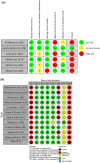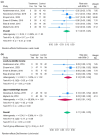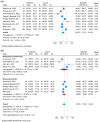Efficacy of skin-to-skin contact between mother and newborn during the third stage of labour in reducing postpartum haemorrhage risk
- PMID: 40181308
- PMCID: PMC11969802
- DOI: 10.1186/s12884-025-07425-2
Efficacy of skin-to-skin contact between mother and newborn during the third stage of labour in reducing postpartum haemorrhage risk
Abstract
Objective: To evaluate the efficacy of skin-to-skin contact (SSC) in reducing the risk of postpartum haemorrhage and blood loss after childbirth.
Background: Postpartum haemorrhage is a leading cause of preventable mortality, particularly in developing countries. Although various strategies exist for its prevention, the effect of SSC remains unclear.
Design: Systematic review with meta-analysis.
Data sources: Searches were conducted in PubMed, Scopus, Cochrane Library, CINAHL, Google Scholar, and Web of Science up to May 2024.
Review methods: The PRISMA guidelines were followed. Prospective clinical trials were included and assessed using the revised Cochrane RoB 2 tool for randomized controlled trials and ROBINS-I for non-randomized studies. The meta-analysis was performed using STATA 18.
Results: The analysis of 18 prospective clinical trials showed that SSC during the third stage of labour was associated with a reduction in the incidence of uterine atony and a lower likelihood of blood loss greater than or equal to 500 mL. Additionally, SSC was linked to a decrease in mean blood loss during the third stage of labour, the first two hours postpartum, and at 24 h postpartum. No significant differences were found in the incidence of severe postpartum haemorrhage.
Conclusions: SSC during the third stage of labour appears to be effective in reducing the risk of uterine atony, blood loss of 500 mL or more, and mean postpartum blood loss. This suggests significant potential for improving obstetric outcomes. However, given the high risk of bias in the studies analysed, caution is required in interpreting these results. Further high-quality research is needed to confirm these benefits, particularly in caesarean sections.
Impact: Postpartum haemorrhage is one of the leading causes of maternal mortality, particularly in developing countries. This meta-analysis suggests that SSC during the third stage of labour could be a key intervention in reducing the risk of uterine atony, blood loss of 500 mL or more, and mean postpartum blood loss. These findings are especially relevant in countries where access to uterotonic drugs is limited, highlighting the need for cost-effective, evidence-based alternatives to improve maternal health.
Patient or public contribution: No patient or public contribution. TRIAL REGISTRATION : PROSPERO registration number CRD 42024543192.
Keywords: Kangaroo-Mother Care Method; Labor Stage, Third; Obstetrical complications; Postpartum Hemorrhage; Skin-to-skin contact; Uterine Atony.
© 2025. The Author(s).
Conflict of interest statement
Declarations. Consent for publication: Not applicable. Competing interests: The authors declare no competing interests.
Figures





Similar articles
-
Folic acid supplementation and malaria susceptibility and severity among people taking antifolate antimalarial drugs in endemic areas.Cochrane Database Syst Rev. 2022 Feb 1;2(2022):CD014217. doi: 10.1002/14651858.CD014217. Cochrane Database Syst Rev. 2022. PMID: 36321557 Free PMC article.
-
Perineal techniques during the second stage of labour for reducing perineal trauma and postpartum complications.Cochrane Database Syst Rev. 2024 Oct 28;10(10):CD016148. doi: 10.1002/14651858.CD016148. Cochrane Database Syst Rev. 2024. PMID: 39465967 Free PMC article.
-
Prophylactic oxytocin for the third stage of labour to prevent postpartum haemorrhage.Cochrane Database Syst Rev. 2019 Apr 29;4(4):CD001808. doi: 10.1002/14651858.CD001808.pub3. Cochrane Database Syst Rev. 2019. PMID: 31032882 Free PMC article.
-
Active versus expectant management for women in the third stage of labour.Cochrane Database Syst Rev. 2019 Feb 13;2(2):CD007412. doi: 10.1002/14651858.CD007412.pub5. Cochrane Database Syst Rev. 2019. PMID: 30754073 Free PMC article.
-
Uterotonic drugs to prevent postpartum haemorrhage: a network meta-analysis.Health Technol Assess. 2019 Feb;23(9):1-356. doi: 10.3310/hta23090. Health Technol Assess. 2019. PMID: 30821683 Free PMC article.
References
-
- Lawrence ER, Klein TJ, Beyuo TK. Maternal Mortality in Low and Middle-Income Countries. Obstet Gynecol Clin North Am. 2022;49:713–33. 10.1016/J.OGC.2022.07.001. - PubMed
-
- Bláha J, Bartošová T. Epidemiology and definition of PPH worldwide. Best Pract Res Clin Anaesthesiol. 2022;36:325–39. 10.1016/J.BPA.2022.11.001. - PubMed
-
- Hersh AR, Carroli G, Hofmeyr GJ, Garg B, Gülmezoglu M, Lumbiganon P, et al. Third stage of labor: evidence-based practice for prevention of adverse maternal and neonatal outcomes. Am J Obstet Gynecol. 2024;230:S1046-S1060.e1. 10.1016/j.ajog.2022.11.1298. - PubMed
Publication types
MeSH terms
LinkOut - more resources
Full Text Sources

